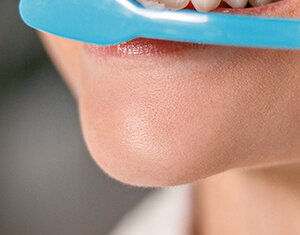Blog
Natural Ingredient Pulling Oil: What is It and How Does it Work?
Oral Care

Oral health is very important to our overall health. Normal dental care, such as brushing and flossing, does not always suffice. What more can we do to improve our dental health? The answer might be found in an archaic technique known as "oil pulling."
Oil pulling is a centuries-old practice that includes swishing oil in your mouth to eliminate germs, reduce inflammation, and enhance dental and general health. When practised on a regular basis, natural ingredient oil pulling is said to heal more than 30 systemic disorders.
Here is what you must know about natural ingredient oil pulling, what is oil pulling, and how it works.
What is Oil Pulling?
So, what is oil pulling? Oil pulling is a ritual that entails swishing oil in your mouth and subsequently expelling it. Commonly, coconut oil, sunflower oil, or sesame seed oil is used, and an alternative option is Dabur Red Pulling oil, featuring a natural fusion of Ayurvedic oils. Integrating this practice into your daily regimen can effectively cleanse the mouth, eliminate toxins, and prevent oral diseases. It is recommended to continue rinsing for approximately 5 to 20 minutes to ensure that the edible oil permeates through the teeth and the entire oral cavity.
What Does Oil Pulling Actually Do?
Engaging in natural ingredient oil pulling can potentially reduce the presence of bacteria in saliva responsible for plaque, gingivitis, and bad breath. To ascertain the true efficacy of oil pulling, you can use natural ingredient oil pulling like Dabur Red Pulling Oil. Despite its unconventional nature compared to a strong brushing and flossing routine, oil pulling might offer some benefits for oral health.
When To Do Oil Pulling?
When is the optimal time for oil pulling for teeth? Should it precede or follow brushing? According to Ayurveda, it is advisable to engage in oil pulling before brushing your teeth and scraping your tongue. If you are deciding between oil pulling at night versus in the morning, the recommendation is always to perform it in the morning on an empty stomach. The rationale behind this is that only during oil pulling on an empty stomach does the mouth release maximum enzyme-rich saliva, facilitating the effective flushing out of toxins and bacteria.
How To Do Oil Pulling?
Optimal benefits from oil pulling are achieved when done before brushing your teeth and on an empty stomach. Follow these simple instructions to know how to do oil pulling correctly:
● Place one tablespoon of oil in your mouth.
● Swirl the oil around in your mouth for 15 minutes, ensuring comprehensive coverage of all areas, including nooks and corners, during gargling.
● For beginners, starting with 5 minutes may be more manageable, gradually increasing the duration to 15 minutes.
● Spit out the oil; do not swallow.
● Continue the process until your mouth feels heavy, as per Ayurveda.
● Take a moment to allow your oral microbiome to rebalance.
● Rinse your mouth with lukewarm water.
● Avoid consuming anything immediately after oil pulling.
Natural Ingredients to Be Used for Oil Pulling
1. Sesame Oil
In the early days, oil pulling for teeth was performed using sesame oil, acclaimed as "The King of Oils" for its abundant nutritional content and versatile qualities.
2. Coconut Oil
The practice of oil pulling for teeth with coconut oil has risen in popularity, primarily attributed to the antimicrobial advantages stemming from its lauric acid content.
3. Dabur Red Pulling Oil
Dabur Red Pulling Oil was specifically formulated to enhance the practice of oil pulling. Developed in accordance with Ayurvedic principles, it melds sesame and coconut oils with the added benefits of Ayurvedic herbs such as Thyme mint, clove, cinnamon oil, Tulsi, and more.
This unique blend of natural oils, scientifically proven to eliminate 99.9% of germs within the mouth, achieves this without resorting to chemicals or alcohol, providing a completely natural approach. Moreover, it contributes to the strengthening of teeth and gums. Consequently, Dabur Red Pulling Oil transcends the conventional notion of a mere mouthwash; instead, it stands as a daily therapeutic regimen for oral health and hygiene.
Conclusion
Certainly, oil pulling for tooth decay has the potential to enhance overall oral health. However, it may not be suitable for everyone, and seeking advice from a healthcare professional is advisable. It's important to note that oil pulling for tooth decay should complement, not substitute, regular tooth care practices. In conclusion, you must ensure to conduct oil pulling using natural ingredient-based products like Dabur Red Pulling Oil. Lastly, you must ensure to visit the dentist regularly to maintain optimal oral health.
FAQs
Is Oil Pulling a replacement for brushing and flossing?
No, Oil Pulling is not a substitute for brushing and flossing. It is performed in conjunction with your regular oral and dental care routine.
How frequently can I engage in Oil Pulling?
You can safely practise Oil Pulling once or twice a day.
Why does the oil turn milky after expulsion?
Oil Pulling effectively removes germs from the mouth. The oil in your mouth emulsifies with your saliva, causing the initially clear oil to become opaque. This transformation serves as a positive indication that the process is effective.
Is there a specific routine I can follow every morning?
Commence by placing a spoonful of the Oil Pulling blend in your mouth. Swish it for 2-3 minutes, then spit it out. Rinse your mouth with water and brush with toothpaste for 2 minutes to conclude your morning routine.
Disclaimer: The contents of this article are for informational purposes only and not a substitute for medical advice.























